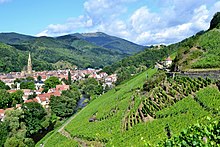Rangen (vineyards)
The Rangen is the southernmost vineyard in Alsace . Rangen has had its own appellation as Alsace Grand Cru since November 23, 1983, making it one of the 51 potentially best locations in Alsace. A total of 18.81 hectares of vineyards were approved.
The location is in the area of the municipalities of Thann and Vieux-Thann , just a few kilometers west of Mulhouse . The Rangen is terraced on a very steep slope with a slope of up to 68 degrees and faces south to south-south-west. The Thur flows at the foot of the vineyard and protects the vineyard from spring frosts thanks to its microclimate.
Soil and climate
Geologically, the Rangen lies on the fault of the Vosges , in the basement from the Devonian and Carboniferous . The rocks that originate from the erosion of the old mountain range and that mixed with volcanic igneous rocks in the sediment are summarized under the term Kulm facies . In the lower area of the location the proportion of greywacke predominates .
The Rangen is the only location in Alsace with volcanic soil. This soil with alkaline lava, ash and tuff as well as coarse sand, siliceous rock provides a wide range of mineral nutrients. In addition, the hard, dark rock of the Grauwacke, which is mainly located in the lower area of the vineyard, stores the heat of the sun. Due to the steepness of the slope, the solar radiation falls almost vertically.
Rangen is the southernmost of the Alsace Grand Cru vineyards. Due to the peripheral location on the southern fault of the Vosges, the location is not protected from precipitation in south-west or west-westerly weather conditions, so that the annual rainfall is a high 1000 mm / year. It is curious that Thann can boast that all of his vineyards are classified as Grand Cru, since other locations, such as the Enchenberg or the Stauffenberg , were abandoned and only the Rangen remained.
Grape varieties
The location and the soil quality favor the cultivation of Pinot Gris (approx. 9 hectares of planted vineyards), Riesling (approx. 4 hectares of planted vineyards), and Gewürztraminer (approx. 1 hectare of planted vineyards). This means that around 14 of the total of 18.81 hectares are under yield. In principle, the Muscat d'Alsace grape variety can also be planted. The wines are currently being marketed by five winemakers.
history
The quality of the range wine has been documented by documents since the 13th century. He was also known for the pilgrims who came to the collegiate church of Sankt Theobald in Thann. As a result, the location was repeatedly mentioned by poets and travelers. However, the church's popularity of wine with pilgrims has always been a thorn in the side, so that they cast Satanic to the rank. The theologian Sebastian Münster expresses himself in his work Cosmographia that the diabolical influence of wine does not make itself noticeable at first because it creeps in like milk. In Johann Fischart's satirical work Affentheurlich Naupengeheurliche Geschichtklitterung it says:
" In the Rangenweim, zu Dann, there is the holy Sankt Rango, who mimics the rank and wrestles so long that he wrestles and braces you under the Baenk ",
and Sebastian Brant wrote that Hercules on his travels through Alsace so much I drank wine that he fell asleep and forgot his club when he woke up.
As early as 1548 and 1581, decrees were issued that prohibited the cultivation of non-noble grape varieties. In certain chronicles it is reported that during the reign of Maria Theresa at the court of Vienna six times more wine from Rangen was consumed than was ever produced. The overall good reputation lasted until the industrial revolution. At that time, the income of the winegrowers no longer justified viticulture due to the low prices and the extremely small properties due to French inheritance law.
Viticulture was only resumed 100 years later through the efforts of Léonard Humbrecht. This late new beginning avoided some mistakes, such as the high yields often found in Alsace, so that the Rangen is often one of the best wines in Alsace today.
literature
- Pierre Galet : Cépages et Vignobles de France . Lavoisier Publishing House, Paris 2004. ISBN 2-7430-0585-8
- Benoît France: Grand Atlas des Vignobles de France . Éditions SOLAR publishing house, Paris 2002. ISBN 2-263-03242-8


